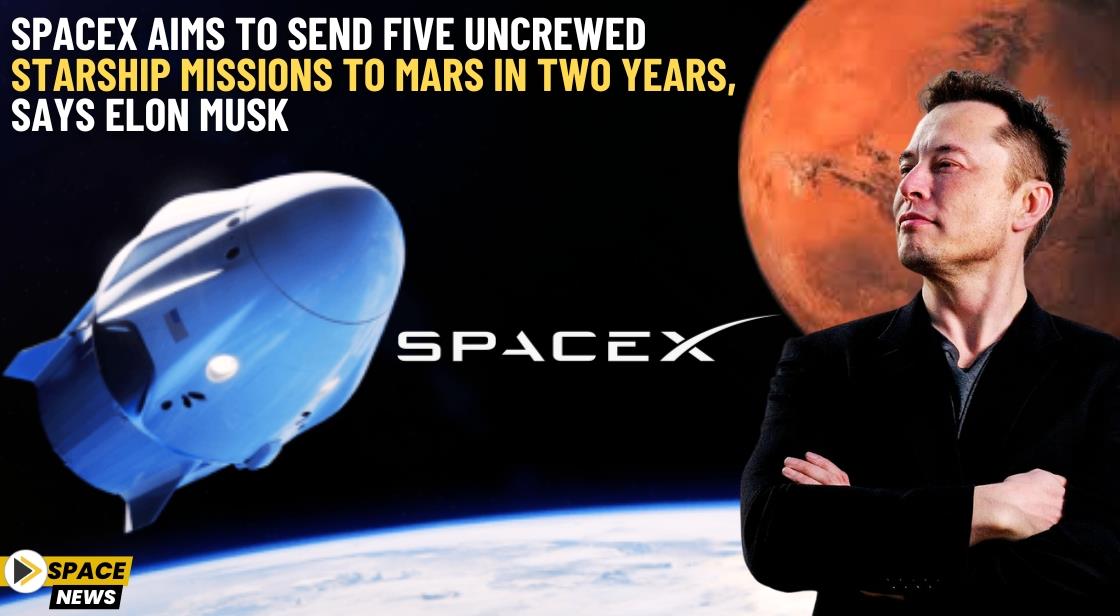SpaceX Aims to Send Five Uncrewed Starship Missions to Mars in Two Years, Says Elon Musk

News Synopsis
SpaceX, led by CEO Elon Musk, is gearing up to launch an ambitious series of uncrewed missions to Mars, with plans to send around five Starships to the red planet in the next two years. Musk shared this significant update on the social media platform X (formerly Twitter) on Sunday, marking a major step toward his long-standing goal of making humanity a multi-planetary species.
The Mars Mission Timeline: First Uncrewed Launches in Two Years
Earlier in September, Musk revealed that the first Starship missions to Mars would align with the next Earth-Mars transfer window, which opens in approximately two years. This crucial period, occurring every 26 months, is when the distance between Earth and Mars is at its shortest, enabling more efficient space travel. “The first Starships to Mars will launch in two years when the next Earth-Mars transfer window opens,” Musk reiterated.
Crew Missions Contingent on Uncrewed Flight Success
On Sunday, Musk provided further insight into SpaceX’s broader mission plans. He stated that the timeline for sending astronauts to Mars will depend on the outcome of these initial uncrewed flights. “If the uncrewed missions land safely, crewed missions will be launched in four years,” Musk said. However, should there be challenges or issues with the uncrewed landings, the timeline for crewed missions will be postponed by another two years.
Musk’s Evolving Timelines for Mars Landings
SpaceX CEO Elon Musk is known for his optimism and sometimes changing timelines regarding Starship’s readiness for Mars missions. Earlier this year, Musk had indicated that the first uncrewed Starship could land on Mars within five years, with humans making the historic first landing within seven years. These projections have now been updated, with uncrewed missions potentially beginning as soon as 2026.
Recent Starship Successes and Challenges
SpaceX has made significant strides with Starship, its next-generation spacecraft designed for deep space exploration. In June, SpaceX achieved a major breakthrough when a Starship rocket survived a hypersonic return from space and successfully landed in the Indian Ocean. This marked the fourth test mission of the rocket and was hailed as a crucial milestone in SpaceX’s efforts to create a reusable spacecraft capable of long-duration space travel.
Starship’s Role in Future NASA and Private Space Missions
Musk’s long-term vision for Starship goes beyond Mars. He envisions it as a large, multi-purpose spacecraft capable of ferrying people and cargo to the Moon, Mars, and beyond. SpaceX’s Starship will also play a pivotal role in NASA's Artemis program, which aims to return humans to the lunar surface for the first time in over 50 years.
However, earlier this year, NASA announced a delay in the Artemis 3 mission, which would see astronauts land on the Moon using Starship. Originally scheduled for late 2025, NASA has now pushed the mission back to September 2026 due to development delays.
Private Missions Also Affected by Starship Delays
SpaceX’s developmental schedule has also impacted private space missions. Japanese billionaire Yusaku Maezawa, who had planned a private Starship mission around the Moon, canceled his trip in June. Maezawa cited uncertainties in Starship's development timeline as the primary reason for calling off the mission, which had been highly anticipated as the first private journey around the Moon.
Despite these setbacks, Musk remains undeterred in his quest to revolutionize space travel and establish human colonies on other planets. With five uncrewed Starship missions potentially heading to Mars in just two years, SpaceX’s ambitious plans could bring humanity one step closer to becoming an interplanetary species.
You May Like









